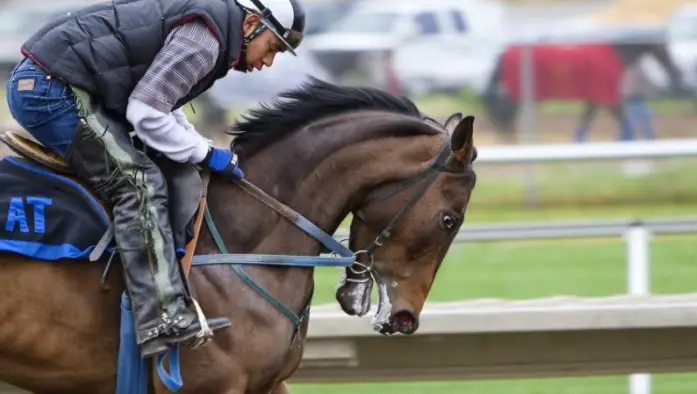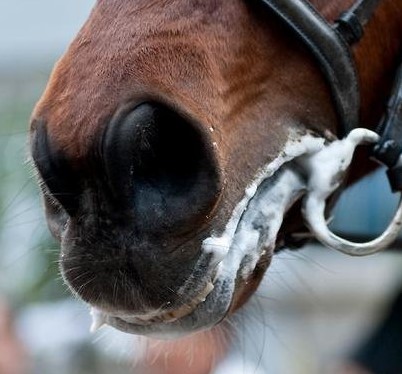Ever wondered why that milky-white froth drools from a horse’s mouth? Some even consider this as a sign of aggressiveness. Moreover, when a horse loudly neighs with a mouth full of foam, it may look threatening. Some opinions point out that this indicates severe disease. Well, none of it is true.
Did you know that creamy foam plays a crucial part in making a horse rideable? In fact, a foamy mouth benefits both the rider and the horse in many ways.
Read on to learn what causes the foam and how the secretion helps to make the horse a unique animal of great worth.

What Causes the Foam?
A protein called latherin causes the thick foam around a horse’s mouth. Both the sweat and the saliva of a horse contain this substance.
In the sweat, latherin acts like soap and repels water. As horses perform heavy tasks carrying humans on top of their back, their body builds up heat. Therefore, they need to dispel the heat sooner and maintain optimal body temperature. Latherin helps in faster evaporation of sweat, thereby cooling the body.

In the saliva, the latherin helps the horses to chew better. Thus, the horse’s jaw muscles and the poll joint (area between the ears) are relaxed after a meal. Typically a horse’s diet consists of dry grass or hay. The protein helps the animal to chew softly by moving its tongue. It also helps in swallowing the dry food without much difficulty.
Latherin also acts as an antimicrobial agent, which is very useful because microorganisms quickly settle down in a horse’s skin when it sweats.
Why Should the Poll Be Relaxed?
While the horse has several essential muscles and bones in its body, nothing works without a relaxed poll joint. It helps a horse keep its head position intact.
If the poll is tight or infected, the horse will bend towards the ground or hold its head up. This will force the horse to either tilt to a side or go backward. Hence, the foam in the mouth is indirectly responsible for a smooth ride.
How Does the Foam Help in Accepting the Bit?
A “bit” is a metal piece inserted in a horse’s mouth that helps the rider control the animal. A foamy mouth is an indication that the horse is comfortable with the bit.
If the bit is too tight, the saliva will not be able to generate foam.
When a horse accepts the bit, its jaw softens and releases large amounts of saliva, resulting in a foamy lip. Air enters the open mouth, leading to even more secretion. The foamy saliva acts as a lubricant and helps soften the friction between the bit and the mouth.
What Amount of Foam Is Usual?
A horse has three salivary glands, and together, they may produce 10 gallons (40 liters) of saliva every day. In comparison, an average human being will secrete only 0.5-1.5 liters per day. Therefore, the amount of saliva around a horse’s mouth becomes a necessary measure.

To illustrate, the most desirable level of foam looks like lipstick applied to the horse’s lips. A horse’s mouth remains partly open when it is focussed on a job, so its lips gently collide, leading to a small foam line.
If the foam is gushing and fills the mouth wholly, that is also fine. Sometimes, after the physical activity ends, horses tend to lick the saliva from the lips and remove the excess lather.
However, if the saliva extends to the neck and remains for hours, it is a sign of trouble. It might mean that the horse is stressed. However, reasons could vary. For instance, it might mean the horse cannot swallow, that the bit is too firm and uncomfortable, or even that the noseband may be tight, preventing the mouth and tongue from moving freely.
On some occasions, excessive secretion may also indicate poisoning.
Does Excessive Foam Indicate Poisoning?
Yes, on some occasions, it does. Red clover poisoning will cause excessive secretion of saliva. The red clover is not poisonous by nature, but if a horse eats one infected by a type of fungus, it might get poisoned. To note, the plant develops black patches when infected.
The poisoning and excess foam may even last three to four days in some cases. But usually, the condition is accompanied by skin lesions, loss of appetite, and breathing difficulties. However, you may exclude poisoning if none of the symptoms appears, along with excessive drooling.
If it’s not life-threatening, usually there’s no need for treatment. Nevertheless, to prevent the horses from consuming the poisonous plant again, they should be kept away from the clover-rich pastures.
What if It Is Rabies?
Rabies also causes excessive foaming in horses. Typically the foam will be long and will extend to the shoulders. Apart from the foam, a sick horse will also act erratically and aggressively.
Rabies in horses is 100% fatal. However, vaccinations are available. What’s more worrying is that rabies can spread even if a human comes into contact with an infected horse’s saliva.
What if There Is No Foam at All?
If a horse is not foaming around its mouth at all, it could be a sign of danger. A foreign object might be choking the horse; thus, an inspection of its throat is necessary. Also, if the horse is suffocating, it will gag and show signs of unrest.
Does the Colour of the Foam Matter?
Yes. Depending on the food being fed to the horse, the color of the foam will differ. If it had grass, the foam might turn greenish. If it ate carrots, we could expect an orange-tinted foam. Nevertheless, red-colored foam needs to be taken a bit more seriously as it can mean that the horse bit its tongue.
Is It Linked to Aggressiveness?
No. It is a popular misconception. An aggressive horse can have foam around its mouth. But not all horses that have foam are aggressive.
Final Thoughts
Amazingly, an innocent-looking creamy liquid in a horse’s mouth serves many purposes. It keeps the horses calm and helps them eat and digest dry foods. Also, it informs the rider that the bit is perfectly placed in the horse’s mouth. Remember, the volume of foam around the mouth can indicate poisoning or even rabies infection.
So the next time you go near a horse, don’t forget to notice that smile behind the foamy fluid.
